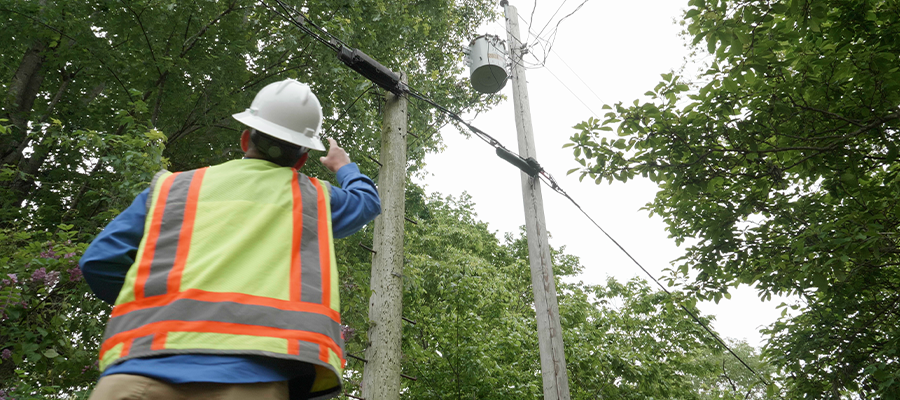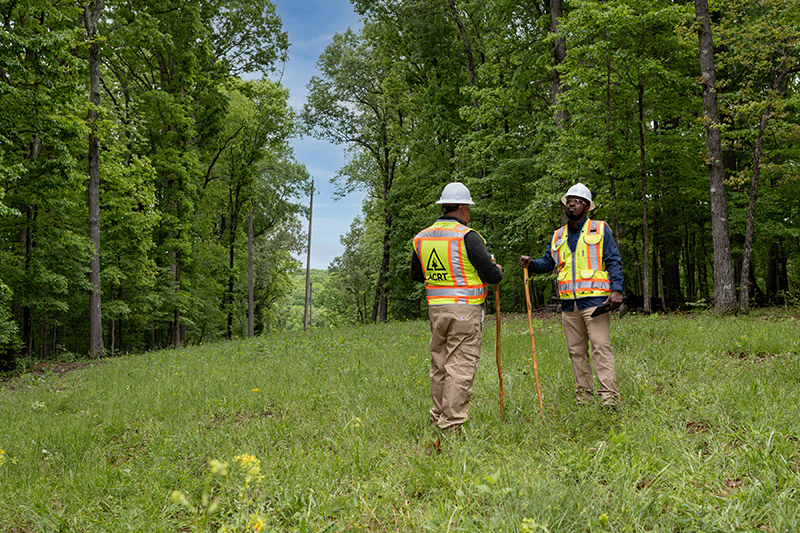- Vegetation Management Services
- Industries
- In Your Neighborhood
- About
- Careers
- Webinars
- Articles
Explore How Utility Arborists Drive Safety, Reliability, and ROI

Explore How Utility Arborists Drive Safety, Reliability, and ROI
Utility arborists are the unsung heroes behind the power grid’s safety and reliability. Tasked with managing vegetation along rights-of-way (ROW), these experts balance regulatory compliance, operational efficiency, and public trust. With increasing demands for reliable service, proactive vegetation management has become a strategic necessity, and utility arborists are at the forefront of delivering measurable results.
This article explores the critical contributions of utility arborists, their methods, and the financial and operational value they bring to utilities.

Why Use Consulting Utility Foresters?
From savings to expertise, CUFs enhance VM.
Why Vegetation Management Matters for Utilities
Vegetation-related issues are one of the leading causes of power outages. A single tree branch touching a power line can result in significant disruptions, costly emergency repairs, and even dangerous wildfires. Additionally, utilities must navigate stringent regulations like FAC-003-4, which mandates strict clearance standards to prevent vegetation encroachments.
The stakes are high:
- Outages Impact Millions: Vegetation-related outages cost utilities billions annually in lost revenue, customer compensation, and emergency responses.
- Regulatory Risks: Non-compliance with vegetation standards can result in hefty fines and reputational damage.
- Community Expectations: As public scrutiny grows, utilities must demonstrate environmental stewardship while maintaining safety and reliability.
Utility arborists provide the expertise needed to address these challenges effectively, ensuring that vegetation management programs are proactive and cost-efficient.
The Expertise of Utility Arborists
Utility arborists bring specialized knowledge to vegetation management, covering every aspect of the process—from planning and execution to quality assurance. Their skillset includes:
- Tree Risk Assessment: Arborists analyze tree health, growth rates, and proximity to power lines to identify hazards before they escalate.
- Regulatory Compliance: Arborists are well-versed in standards like FAC-003-4 and ANSI Z133, ensuring utilities remain compliant and avoid penalties.
- Strategic Planning: By prioritizing high-risk areas, arborists create efficient work plans that reduce costs and optimize resources.
- Community Engagement: Arborists serve as liaisons with landowners, fostering trust and minimizing resistance to vegetation work.
The Plan, Do, Check Process
Utility arborists follow a structured “Plan, Do, Check” methodology to deliver consistent, high-quality results:
- Plan:
During this phase, arborists assess ROWs, identify hazard trees, and develop data-driven vegetation management plans. By analyzing factors like tree species and environmental conditions, arborists prioritize high-risk areas and optimize maintenance schedules. - Do:
Arborists oversee the execution of vegetation management work, ensuring compliance with safety and operational standards. They engage with landowners to address concerns and facilitate smooth project implementation. - Check:
After work is completed, arborists conduct audits to verify compliance, quality, and safety. These evaluations provide insights for refining future strategies, ensuring continuous improvement.
The ROI of Utility Arborists
Investing in utility arborists delivers significant financial and operational benefits. Key areas of impact include:
- Reduced Outage Costs
Proactive vegetation management prevents outages caused by encroaching vegetation. By addressing hazards early, utilities avoid costly emergency repairs and maintain service reliability. - Optimized Maintenance Cycles
Arborists develop efficient work plans that extend the time between maintenance cycles, reducing operational costs without compromising safety. - Compliance Savings
Regular audits and adherence to standards like FAC-003-4 protect utilities from fines and liability, safeguarding budgets and reputations. - Enhanced Customer Satisfaction
Transparent communication with landowners builds trust, minimizing project delays and improving public perception. - Environmental Stewardship
Arborists implement sustainable practices, such as selective pruning and natural regeneration, aligning vegetation management with ecological goals.
Case in Point: The Value of Proactive Management
Consider a utility in a storm-prone region. Without proactive vegetation management, heavy winds can turn overgrown trees into hazards, causing outages that disrupt service to thousands of customers. By employing utility arborists, the utility:
- Conducted thorough ROW assessments to identify and mitigate risks.
- Reduced vegetation-related outages by 40% over two years.
- Saved $3 million annually by optimizing maintenance schedules and reducing emergency response costs.
This example highlights how arborists transform vegetation management from a reactive cost center to a proactive investment.
Challenges Faced by Utility Arborists
Despite their expertise, utility arborists face several challenges, including:
- Aging Infrastructure: Managing vegetation around aging power infrastructure adds complexity to their work.
- Public Perception: Landowners often resist vegetation work, viewing it as disruptive. Arborists must navigate these sensitivities carefully.
- Workforce Gaps: A shortage of skilled arborists means utilities must compete for top talent, driving up costs.
Addressing these challenges requires utilities to prioritize training, invest in technology, and foster strong community relationships.
Technology and Innovation in Vegetation Management
Utility arborists increasingly leverage technology to enhance their work:
- GIS Mapping: Geographic Information Systems help arborists map ROWs and analyze vegetation risks with precision.
- Drones: Unmanned aerial vehicles provide a bird’s-eye view of vegetation near power lines, improving risk assessments.
- Remote Sensing: LiDAR and satellite imagery enable arborists to monitor vegetation growth and prioritize maintenance.
By embracing these innovations, utilities can improve efficiency and accuracy in their vegetation management programs.
Conclusion: A Strategic Asset for Utilities
Utility arborists are more than vegetation management professionals — they’re strategic partners who help utilities achieve safety, compliance, and cost efficiency. Their expertise in planning, execution, and quality assurance transforms vegetation management into a proactive, ROI-driven function.
As utilities face increasing demands for reliability and compliance, the role of utility arborists will continue to grow in importance. By investing in these experts, utilities can ensure long-term success while delivering safe and reliable service to their customers.
Contact us today to learn how utility arborists can enhance your vegetation management program.
Related Articles

Servant Leadership in Utility Vegetation Management By C. Troy Ross, President, ACRT and ACRT Pacific On a chilly Monday morning, a utility vegetation management crew gathers for their weekly briefing. Instead of launching into instructions, their supervisor begins by asking each team member how they’re doing. One mentions a child’s illness, another shares excitement about[...]
Read More
Turning Vegetation Waste into Opportunity By Aana Agrawal, Sustainability and Resilience Manager, EnviroScience The utility vegetation management (UVM) sector plays a crucial role in ensuring the smooth transmission of power across regions and cities by keeping plant growth under control within the vicinity of transmission and distribution lines. However, unrefined vegetation maintenance practices often focus[...]
Read More
Reflections from Will Nutter Silver Shield Award Recipients By Bob Urban, Senior Manager, ACRT Services In an industry where the stakes are high and every decision can have life-altering consequences, leadership in utility arboriculture isn’t just a managerial function; it’s a calling. Nowhere is this more evident than in the recipients of the Will Nutter[...]
Read More
The Electric Butterfly: Reconnecting with Nature on the Edges By Ryan Meccage, Business Development Manager, ACRT Services In an age dominated by smartphones, constant connectivity, and algorithm-driven content, we’ve never been more digitally immersed. Yet somehow, we’ve also never felt so far removed from the natural world beneath our feet. The urge to step away[...]
Read MoreRecent Posts
- Alex Fields Awarded ACRT Safety Challenge Coin 20th Nov 2025
- Servant Leadership in Utility Vegetation Management 12th Nov 2025
- ACRT Honors Our Veterans 10th Nov 2025
- Anna Davis Awarded Safety Challenge Coin 04th Nov 2025
- ACRT Senior Consulting Utility Forester Recognized as Safety Superstar 15th Oct 2025
Categories
The Leader In Vegetation Management
We are all about people, and we put safety first. Ready to work with our well-trained team?